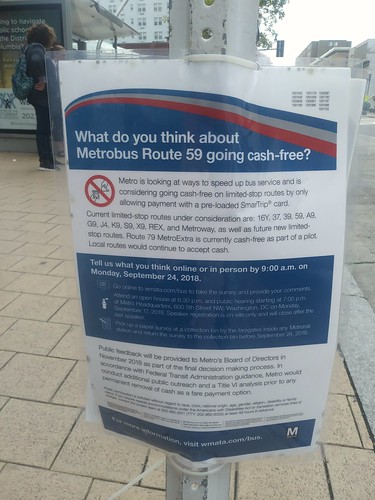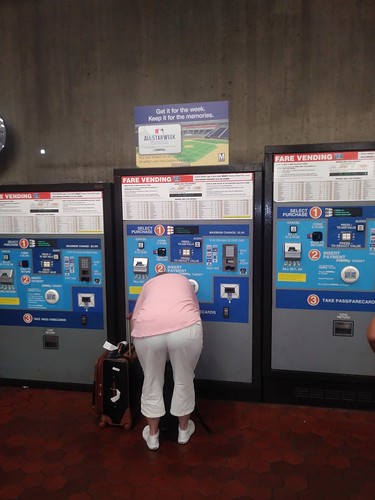WMATA Metrobus proposes to go cashless on limited stop (rapid) bus services
I didn't write about it, but last Monday was the deadline to submit comments about WMATA's plans to go cashless on the limited stop bus services, to reduce dwell time, both from taking cash for fares or adding cash to a SmarTrip card, which is a cumbersome and time consuming process at the fare machine on the buses.
-- Printed survey
I answered the online survey and submitted a brief set of "comments." Mostly the submission was photos of marketing by Transport for London about places where people can put money cash or credit on their Oyster cards, outside or or external to transit stations.
User experience. While I support moving to cashless to speed up bus service, I argued that moving to cashless without having fare card machines outside of train stations and greater attention paid to locations where riders can put money on their SmarTrip cards in more convenient ways does riders a disservice. Access to farecard services outside of the Metrorail system is the primary point as it relates to "user experience."
(The sections on:
from the entry "World Usability Day," discuss "transit user experience" matters in greater depth.)
Machines for buying Metrocards and adding money to them (either cash or credit) are only located within Metrorail stations.
Farecard machines aren't present on the surface at major bus stops where lines intersect--although the big hulking machines could be replaced by smaller ATM-like machines for non-station locations.
Note the the Transport for London ticket machine in the center of the picture above. It's small enough to be able to be built into building facades, just like an ATM. (One issue with stand-alone machines is security. And admittedly, one issue with machines outside of Metrorail stations is the cost to service and operate them.)
Some retail stores service SmarTrip cards. While there aren't WMATA fare machines outside of transit stations, it is possible to put money on cards at CVS Pharmacy, Giant Supermarkets, and Walmart stores, and certain other outlets. Some sell the cards too (Giant, Walmart primarily).
Earlier this year CVS threatened to stop doing so because of problems working with WMATA ("CVS Agrees to Continue Selling Metro's SmarTrip Cards," NBC4).
It used to be that there was SmarTrip signage on some of the storefronts. Even when present the materials aren't particularly noticeable.
Yesterday, I looked at the facades of five CVS stores in DC and Silver Spring, Maryland and didn't see any signage for the SmarTrip card program. And Giant has a decal at the entryway stating all the non-grocery services they provide (selling stamps, etc.) and this decal does not list selling or adding money to SmarTrip cards.
Transport for London's marketing of off-transit Oyster card services. That's why I submitted images from London.
Like this storefront in Hackney Borough on the Mare Street pedestrian mall, about one block from the Hackney Central London Overground Station. Note the lighted sign reproductions of the Oyster card, communicating very clearly that the store offers Oyster-related services.
One of the marketing programs for off-site Oyster card money-adding services is called "Oyster Ticket Stop" and TfL provides a variety of graphic design treatments for affixing to storefronts.
Labels: bus transit, customer service, design method, mobility as a service (MaaS), sustainable mobility platform, transit marketing, transportation planning, user experience




















3 Comments:
Its a good idea but WMATA won't be able to implement it because of the inability to conveniently add value to farecards. Simpler and more plentiful machines should be everywhere, but SmartTrip is too limited and WMATA can't maintain or manage anything. Even if you add value online, it can take days to show up. And as much as a drag as poor people are, I'm sympathetic enough to understand that planning ahead financially isn't their strong suit for various reasons. I've always thought buses should have a 2nd touch point rearward of the driver, so passengers could add fare or whatever during the ride instead of holding up boarding. For buses, I honestly think bringing back tokens would be a better idea. Just put them out as pseudo-currency and let the market figure it out. WMATA sure can't figure out anything.
I've never added money online. I didn't realize that it takes a long time to show up. I know that my one experience doing something like that, with the Orca card in Seattle, was similarly frustrating. It only is batch updated.
But I think the "instantaneous add" from a machine works pretty well.
Your idea of a second touchpoint on buses is excellent. But then so would fare machines on the surface.
===
but about machines and software, I was alluding to but didn't say. When I was in the process of writing this entry, I was thinking of the "President's Council" of transit agencies that created the standardized PCC car.
Why doesn't the APTA take the lead with transit agencies and develop standardized systems, in particular fare card machines.
WRT software, there are industry standards etc., but I don't understand why everyone needs to still have their own super specific implementation. E.g., that DC and Baltimore use the same card system is actually miraculous in the great scheme of things.
They should extend it to Virginia systems too, since the State of Virginia is a member of the compact.
Similarly, what Ontario did is a big thing too. It's complicated in Ottawa though because the suburbs are in Quebec and they don't participate.
I haven't done it in awhile, but even after you "add" it online, you have to "touch" the card within a certain period of time to "load" the money, else the transaction is cancelled. Aaand, the lag time is different between bus, rail, or other "touchpoints." So it is possible to add funds online, but then go to use it but the funds haven't transferred yet so you can't get through a fare gate (or more likely) pay bus fare. Its all annoying inconvenient and stupid. If you are a daily rider and your fare card has a cushion of value on it, its ok, but if you are an infrequent user it can be a pain. I can't blame the poor and luddites for wanting to stick with cash b/c if you have it in your hand at least you know its there.
Post a Comment
<< Home